YAMAHA GIGGLE50 2009 Workshop Manual
Manufacturer: YAMAHA, Model Year: 2009, Model line: GIGGLE50, Model: YAMAHA GIGGLE50 2009Pages: 74, PDF Size: 0.9 MB
Page 51 of 74
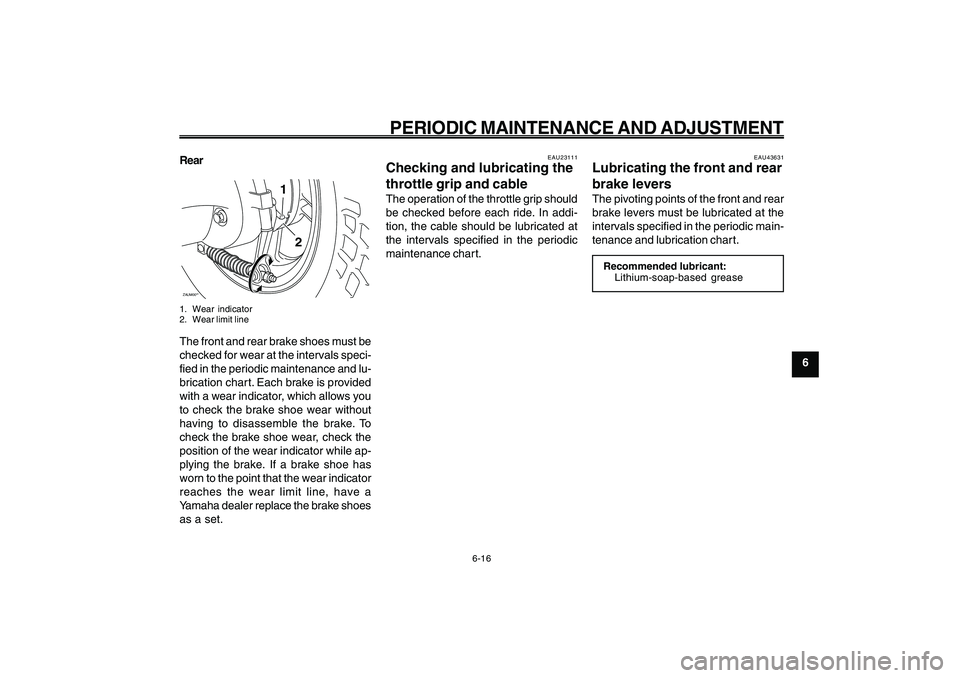
6-51
1
2
3
4
5
6
7
8
9
EAU1722A
PERIODIC MAINTENANCE AND ADJUSTMENT
6-16
RearZAUM00**
1
2
1. Wear indicator
2. Wear limit lineThe front and rear brake shoes must be
checked for wear at the intervals speci-
fied in the periodic maintenance and lu-
brication chart. Each brake is provided
with a wear indicator, which allows you
to check the brake shoe wear without
having to disassemble the brake. To
check the brake shoe wear, check the
position of the wear indicator while ap-
plying the brake. If a brake shoe has
worn to the point that the wear indicator
reaches the wear limit line, have a
Yamaha dealer replace the brake shoes
as a set.
EAU23111
Checking and lubricating the
throttle grip and cableThe operation of the throttle grip should
be checked before each ride. In addi-
tion, the cable should be lubricated at
the intervals specified in the periodic
maintenance chart.
EAU43631
Lubricating the front and rear
brake leversThe pivoting points of the front and rear
brake levers must be lubricated at the
intervals specified in the periodic main-
tenance and lubrication chart.Recommended lubricant:
Lithium-soap-based grease
Throttle grip and cable, checking and lubricating
Brake levers, lubricating
Page 52 of 74
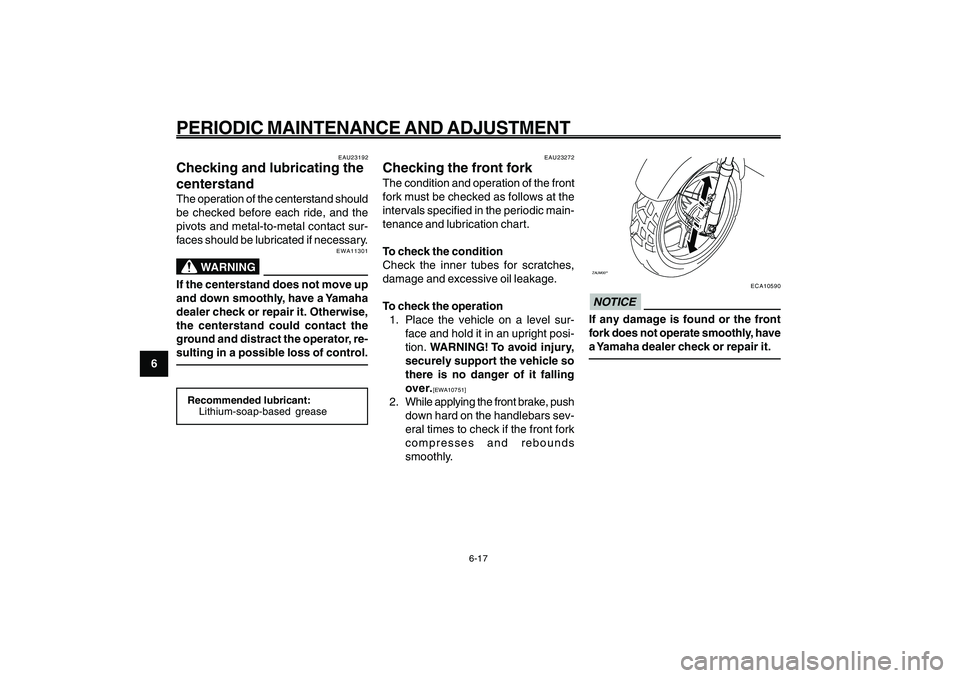
6-52
1
2
3
4
5
6
7
8
9
EAU1722A
PERIODIC MAINTENANCE AND ADJUSTMENT
6-17
Centerstand, checking and lubricating
Front fork, checking
EAU23192
Checking and lubricating the
centerstandThe operation of the centerstand should
be checked before each ride, and the
pivots and metal-to-metal contact sur-
faces should be lubricated if necessary.
EWA11301
WARNING
If the centerstand does not move up
and down smoothly, have a Yamaha
dealer check or repair it. Otherwise,
the centerstand could contact the
ground and distract the operator, re-
sulting in a possible loss of control.Recommended lubricant:
Lithium-soap-based grease
EAU23272
Checking the front forkThe condition and operation of the front
fork must be checked as follows at the
intervals specified in the periodic main-
tenance and lubrication chart.
To check the condition
Check the inner tubes for scratches,
damage and excessive oil leakage.
To check the operation
1. Place the vehicle on a level sur-
face and hold it in an upright posi-
tion. WARNING! To avoid injury,
securely support the vehicle so
there is no danger of it falling
over.
[EWA10751]
2. While applying the front brake, push
down hard on the handlebars sev-
eral times to check if the front fork
compresses and rebounds
smoothly.
ZAUM00**
ECA10590
NOTICEIf any damage is found or the front
fork does not operate smoothly, have
a Yamaha dealer check or repair it.
Page 53 of 74
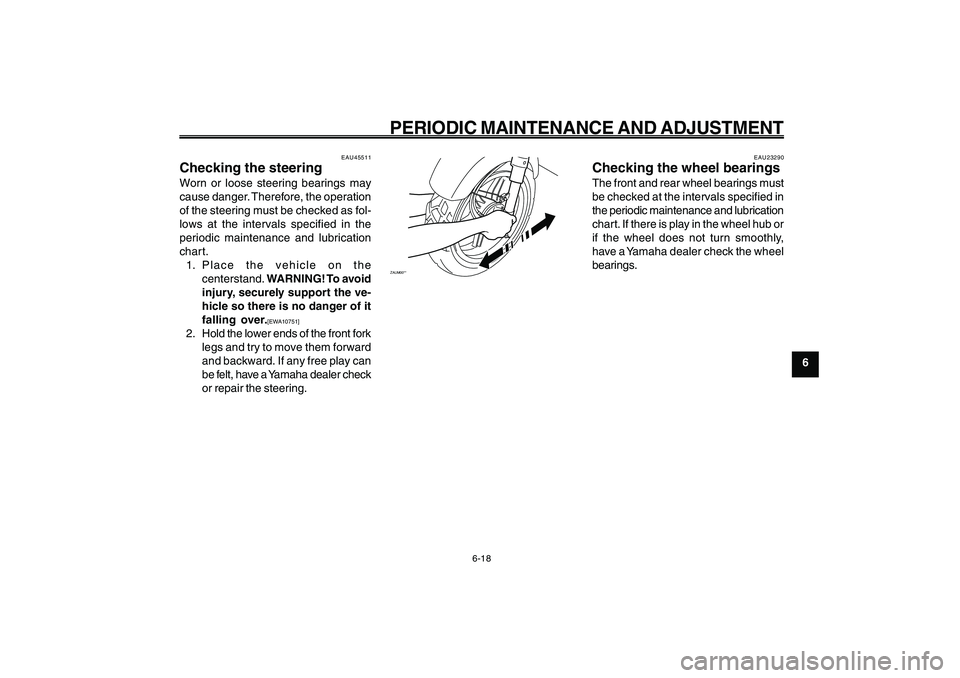
6-53
1
2
3
4
5
6
7
8
9
EAU1722A
PERIODIC MAINTENANCE AND ADJUSTMENT
6-18
Steering, checking
Wheel bearings, checking
EAU45511
Checking the steeringWorn or loose steering bearings may
cause danger. Therefore, the operation
of the steering must be checked as fol-
lows at the intervals specified in the
periodic maintenance and lubrication
chart.
1. Place the vehicle on the
centerstand. WARNING! To avoid
injury, securely support the ve-
hicle so there is no danger of it
falling over.
[EWA10751]
2. Hold the lower ends of the front fork
legs and try to move them forward
and backward. If any free play can
be felt, have a Yamaha dealer check
or repair the steering.
ZAUM00**
EAU23290
Checking the wheel bearingsThe front and rear wheel bearings must
be checked at the intervals specified in
the periodic maintenance and lubrication
chart. If there is play in the wheel hub or
if the wheel does not turn smoothly,
have a Yamaha dealer check the wheel
bearings.
Page 54 of 74
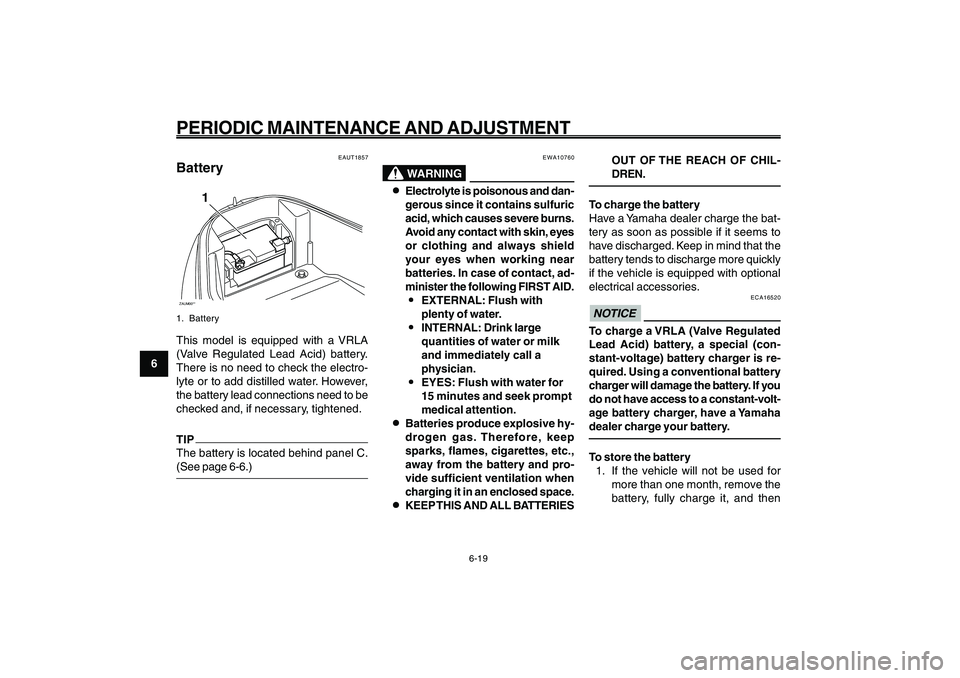
6-54
1
2
3
4
5
6
7
8
9
EAU1722A
PERIODIC MAINTENANCE AND ADJUSTMENT
6-19
EAUT1857
BatteryZAUM00**
1
1. BatteryThis model is equipped with a VRLA
(Valve Regulated Lead Acid) battery.
There is no need to check the electro-
lyte or to add distilled water. However,
the battery lead connections need to be
checked and, if necessary, tightened.TIP
The battery is located behind panel C.
(See page 6-6.)Battery
EWA10760
WARNING
8 88 8
8Electrolyte is poisonous and dan-
gerous since it contains sulfuric
acid, which causes severe burns.
Avoid any contact with skin, eyes
or clothing and always shield
your eyes when working near
batteries. In case of contact, ad-
minister the following FIRST AID.
9 99 9
9EXTERNAL: Flush with
plenty of water.
9 99 9
9INTERNAL: Drink large
quantities of water or milk
and immediately call a
physician.
9 99 9
9EYES: Flush with water for
15 minutes and seek prompt
medical attention.
8 88 8
8Batteries produce explosive hy-
drogen gas. Therefore, keep
sparks, flames, cigarettes, etc.,
away from the battery and pro-
vide sufficient ventilation when
charging it in an enclosed space.
8 88 8
8KEEP THIS AND ALL BATTERIESOUT OF THE REACH OF CHIL-
DREN.
To charge the battery
Have a Yamaha dealer charge the bat-
tery as soon as possible if it seems to
have discharged. Keep in mind that the
battery tends to discharge more quickly
if the vehicle is equipped with optional
electrical accessories.
ECA16520
NOTICETo charge a VRLA (Valve Regulated
Lead Acid) battery, a special (con-
stant-voltage) battery charger is re-
quired. Using a conventional battery
charger will damage the battery. If you
do not have access to a constant-volt-
age battery charger, have a Yamaha
dealer charge your battery.To store the battery
1. If the vehicle will not be used for
more than one month, remove the
battery, fully charge it, and then
Page 55 of 74
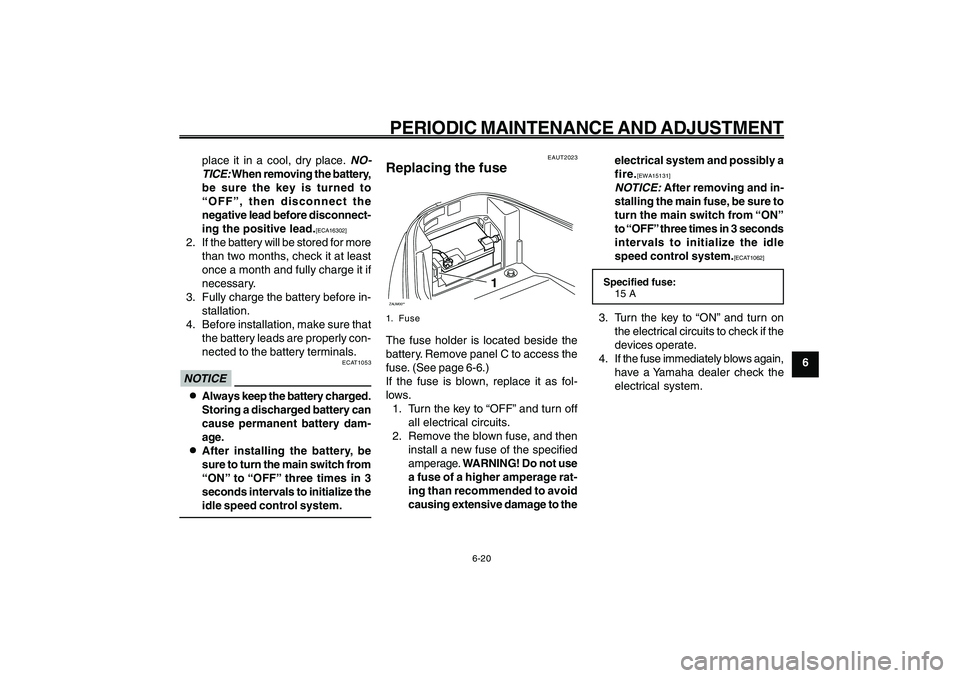
6-55
1
2
3
4
5
6
7
8
9
EAU1722A
PERIODIC MAINTENANCE AND ADJUSTMENT
6-20
place it in a cool, dry place.
NO-
TICE:
When removing the battery,
be sure the key is turned to
“OFF”, then disconnect the
negative lead before disconnect-
ing the positive lead.
[ECA16302]
2. If the battery will be stored for more
than two months, check it at least
once a month and fully charge it if
necessary.
3. Fully charge the battery before in-
stallation.
4. Before installation, make sure that
the battery leads are properly con-
nected to the battery terminals.
ECAT1053
NOTICE8 88 8
8Always keep the battery charged.
Storing a discharged battery can
cause permanent battery dam-
age.
8 88 8
8After installing the battery, be
sure to turn the main switch from
“ON” to “OFF” three times in 3
seconds intervals to initialize the
idle speed control system.Fuse, replacing
EAUT2023
Replacing the fuseZAUM00**
1
1. FuseThe fuse holder is located beside the
battery. Remove panel C to access the
fuse. (See page 6-6.)
If the fuse is blown, replace it as fol-
lows.
1. Turn the key to “OFF” and turn off
all electrical circuits.
2. Remove the blown fuse, and then
install a new fuse of the specified
amperage. WARNING! Do not use
a fuse of a higher amperage rat-
ing than recommended to avoid
causing extensive damage to theelectrical system and possibly a
fire.
[EWA15131]
NOTICE:
After removing and in-
stalling the main fuse, be sure to
turn the main switch from “ON”
to “OFF” three times in 3 seconds
intervals to initialize the idle
speed control system.
[ECAT1062]
Specified fuse:
15 A3. Turn the key to “ON” and turn on
the electrical circuits to check if the
devices operate.
4. If the fuse immediately blows again,
have a Yamaha dealer check the
electrical system.
Page 56 of 74
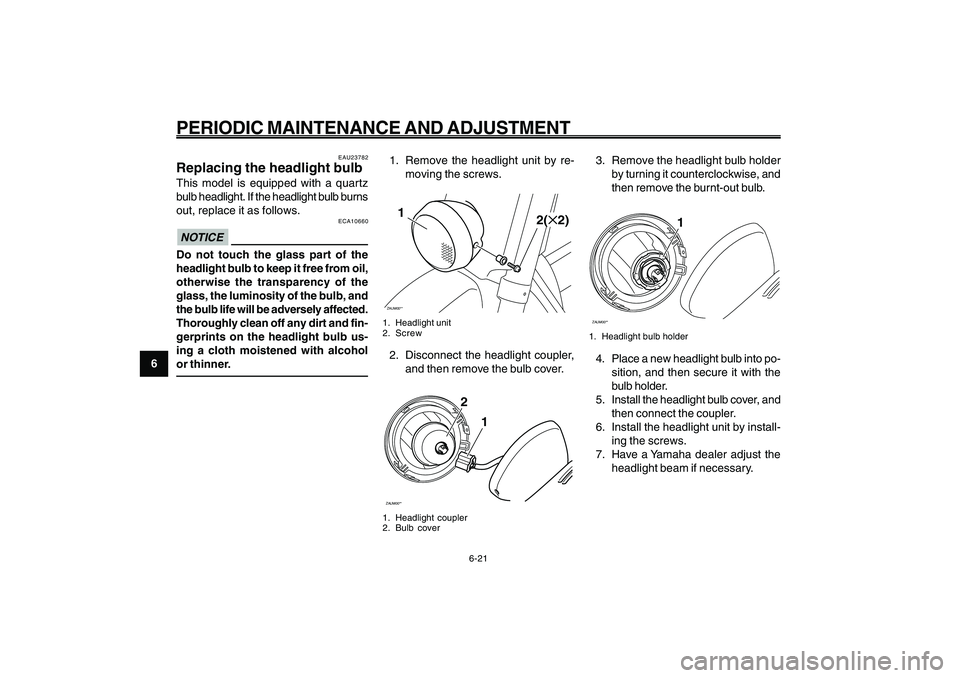
6-56
1
2
3
4
5
6
7
8
9
EAU1722A
PERIODIC MAINTENANCE AND ADJUSTMENT
6-21
1. Remove the headlight unit by re-
moving the screws.ZAUM00**1
2(✕2)
1. Headlight unit
2. Screw2. Disconnect the headlight coupler,
and then remove the bulb cover.ZAUM00**
2
1
1. Headlight coupler
2. Bulb cover
3. Remove the headlight bulb holder
by turning it counterclockwise, and
then remove the burnt-out bulb.ZAUM00**
1
1. Headlight bulb holder4. Place a new headlight bulb into po-
sition, and then secure it with the
bulb holder.
5. Install the headlight bulb cover, and
then connect the coupler.
6. Install the headlight unit by install-
ing the screws.
7. Have a Yamaha dealer adjust the
headlight beam if necessary. Headlight bulb, replacing
EAU23782
Replacing the headlight bulbThis model is equipped with a quartz
bulb headlight. If the headlight bulb burns
out, replace it as follows.
ECA10660
NOTICEDo not touch the glass part of the
headlight bulb to keep it free from oil,
otherwise the transparency of the
glass, the luminosity of the bulb, and
the bulb life will be adversely affected.
Thoroughly clean off any dirt and fin-
gerprints on the headlight bulb us-
ing a cloth moistened with alcohol
or thinner.
Page 57 of 74
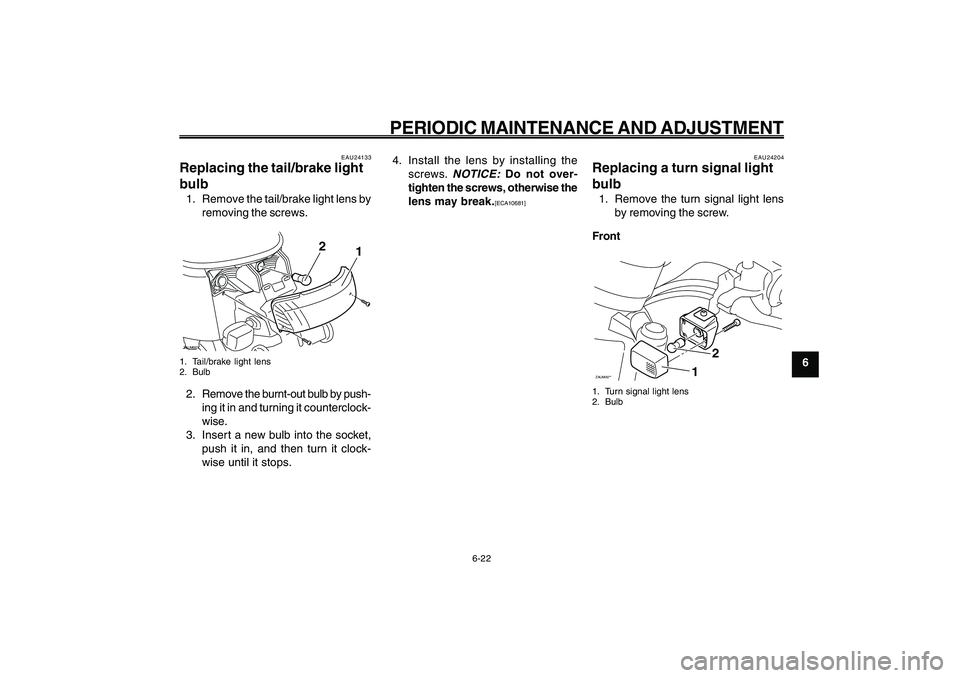
6-57
1
2
3
4
5
6
7
8
9
EAU1722A
PERIODIC MAINTENANCE AND ADJUSTMENT
6-22
Tail/brake light bulb, replacing
Turn signal light bulb, replacing
EAU24204
Replacing a turn signal light
bulb1. Remove the turn signal light lens
by removing the screw.
FrontZAUM00**
2
1
1. Turn signal light lens
2. Bulb
EAU24133
Replacing the tail/brake light
bulb1. Remove the tail/brake light lens by
removing the screws.ZAUM00**
1
2
1. Tail/brake light lens
2. Bulb2. Remove the burnt-out bulb by push-
ing it in and turning it counterclock-
wise.
3. Insert a new bulb into the socket,
push it in, and then turn it clock-
wise until it stops.4. Install the lens by installing the
screws.
NOTICE:
Do not over-
tighten the screws, otherwise the
lens may break.[ECA10681]
Page 58 of 74
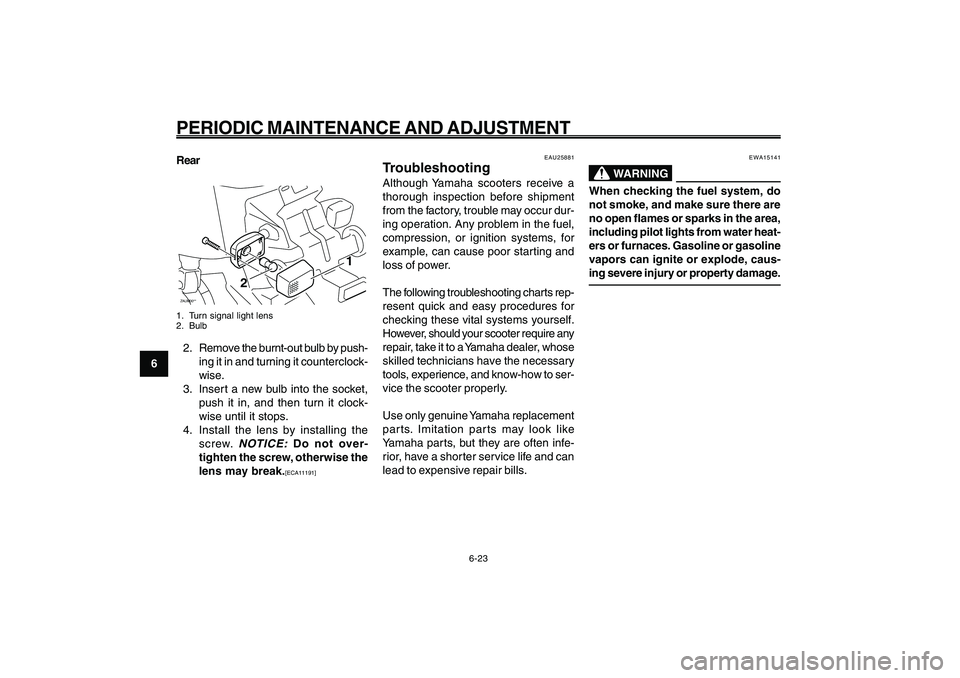
6-58
1
2
3
4
5
6
7
8
9
EAU1722A
PERIODIC MAINTENANCE AND ADJUSTMENT
6-23
EWA15141
WARNING
When checking the fuel system, do
not smoke, and make sure there are
no open flames or sparks in the area,
including pilot lights from water heat-
ers or furnaces. Gasoline or gasoline
vapors can ignite or explode, caus-
ing severe injury or property damage.
EAU25881
TroubleshootingAlthough Yamaha scooters receive a
thorough inspection before shipment
from the factory, trouble may occur dur-
ing operation. Any problem in the fuel,
compression, or ignition systems, for
example, can cause poor starting and
loss of power.
The following troubleshooting charts rep-
resent quick and easy procedures for
checking these vital systems yourself.
However, should your scooter require any
repair, take it to a Yamaha dealer, whose
skilled technicians have the necessary
tools, experience, and know-how to ser-
vice the scooter properly.
Use only genuine Yamaha replacement
parts. Imitation par ts may look like
Yamaha parts, but they are often infe-
rior, have a shorter service life and can
lead to expensive repair bills. Troubleshooting
Rear
ZAUM00**
1
2
1. Turn signal light lens
2. Bulb2. Remove the burnt-out bulb by push-
ing it in and turning it counterclock-
wise.
3. Insert a new bulb into the socket,
push it in, and then turn it clock-
wise until it stops.
4. Install the lens by installing the
screw.
NOTICE:
Do not over-
tighten the screw, otherwise the
lens may break.[ECA11191]
Page 59 of 74
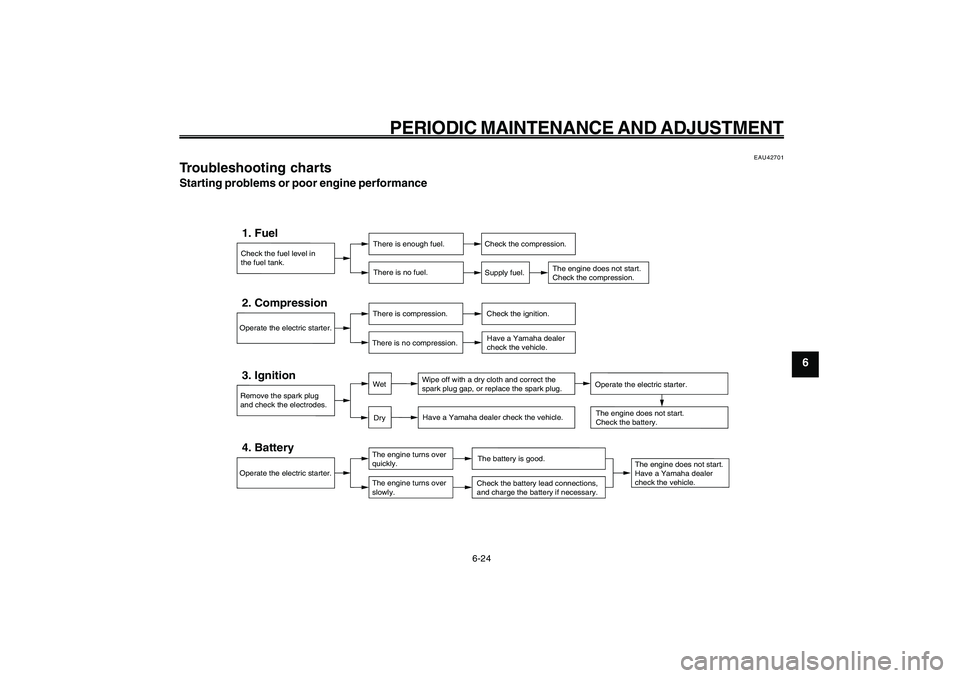
6-59
1
2
3
4
5
6
7
8
9
EAU1722A
PERIODIC MAINTENANCE AND ADJUSTMENT
Troubleshooting char ts
Check the fuel level in
the fuel tank.1. Fuel
There is enough fuel.
There is no fuel.
Check the compression.
Supply fuel.
The engine does not start.
Check the compression.
Operate the electric starter.2. Compression
There is compression.
There is no compression.
Check the ignition.
Have a Yamaha dealer
check the vehicle.
Remove the spark plug
and check the electrodes.3. Ignition
Wipe off with a dry cloth and correct the
spark plug gap, or replace the spark plug.
Have a Yamaha dealer check the vehicle.
The engine does not start.
Have a Yamaha dealer
check the vehicle.
The engine does not start.
Check the battery.
Operate the electric starter.4. Battery
The engine turns over
quickly.
The engine turns over
slowly.
The battery is good.Check the battery lead connections,
and charge the battery if necessary.
DryWet
Operate the electric starter.
6-24
EAU42701
Troubleshooting chartsStarting problems or poor engine performance
Page 60 of 74

6-60
1
2
3
4
5
6
7
8
9
EAU1722A
PERIODIC MAINTENANCE AND ADJUSTMENT
6-25
Wait until the
engine has cooled.
Check the coolant level in the
reservoir and radiator.
The coolant level
is OK.The coolant level is low.
Check the cooling system
for leakage.
Have a Yamaha dealer checkand repair the cooling system.Add coolant. (See TIP.)
Start the engine. If the engine overheats again,
have a
Yamaha dealer check
and repair the cooling system.
There is
leakage.
There is
no leakage.
Engine overheating
EWAT1040
WARNING
8 88 8
8Do not remove the radiator cap when the engine and radiator are hot. Scalding hot fluid and steam may be
blown out under pressure, which could cause serious injury. Be sure to wait until the engine has cooled.
8 88 8
8Place a thick rag, like a towel, over the radiator cap, and then slowly rotate the cap counterclockwise to the
detent to allow any residual pressure to escape. When the hissing sound has stopped, press down on the cap
while turning it counterclockwise, and then remove the cap.TIP
If coolant is not available, tap water can be temporarily used instead, provided that it is changed to the recommended coolant
as soon as possible.